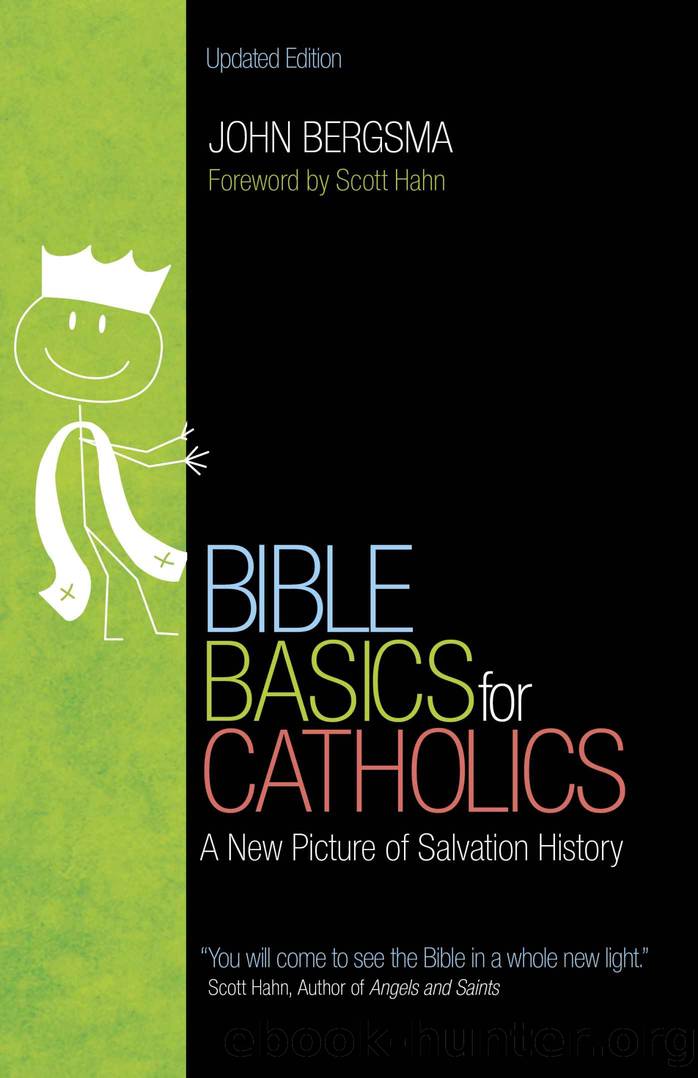Bible Basics for Catholics by John Bergsma

Author:John Bergsma [Bergsma, John]
Language: eng
Format: epub
Publisher: Ave Maria Press
Published: 2015-10-02T05:00:00+00:00
Now, as we’ve seen, this New Covenant spoken of by the prophets includes the restoration and transformation of the Davidic Covenant. The Davidic king is going to return, so let’s put him in with dotted lines:
And, as Ezekiel especially emphasizes, we are going to get a new temple as well:
There. That’s our icon for the New Covenant in the prophets. This is how far we’ve come in salvation history:
Seven
The Grand Finale:
The Eucharistic Covenant
Suggested Reading: Luke 22–24; Acts 1–2
Ezekiel, the last of the three great prophets of the Jewish tradition, finished prophesying around 570 BC. That means it was about 570 years before Jesus appeared in history. What was going on in the meantime?
The prophet Daniel was only a little younger than Ezekiel and prophesied shortly after him. Roughly thirty years after the death of Ezekiel, Daniel received a vision from God that it would take about five hundred years (“seventy weeks of years”) for all the prophecies to be fulfilled (Dn 9:24–27). And so it did.
Of course, a lot happened in that time. In 539 BC, about the time Daniel was having his vision, the Persians conquered the Babylonians and took over the Middle East. The Persians were nicer than the Babylonians and let all the captured peoples go home, including the Jews. This is what we call “the return from exile.”
Led by the prince Zerubbabel, the prophet Ezra, the aristocrat Nehemiah, and many other prophets and noblemen, the Jews came back from Babylon in several waves in the late 500s and early 400s. By 515 BC, they had built another temple on the site of the old one, but it was a pretty sorry shack compared to the magnificent building Solomon had put up. But at least they had a place to worship God once again.
The return from exile was a mixed bag. On the positive side, the Jews had much of their land back, and they had a temple to worship God. On the other hand, they didn’t have a Davidic king on the throne, their temple was a disappointment, and there was no sign of the New Covenant and the glorious New Temple that the prophets had promised. In fact, the Jews weren’t even able to rule themselves. At first they were under the power of the Persians, and then after Alexander the Great swept through the Middle East in the 330s, they were ruled by him and his Greek-speaking successors (1 Mc 1:1–8).
However, two events gave rise to false hopes that the predictions of the great prophets were about to be fulfilled.
In the 160s BC, one of Alexander’s successors, King Antiochus IV, whose capital was in Syria, took a hard line against the Jews he ruled. He tried to make them give up their religion. The Jews revolted under the leadership of a family of Levites known as the Maccabees (known also as the Hasmoneans). The Maccabees fought a guerilla war against the armies of Antiochus and eventually drove them out of Israel (1 Mc). For
Download
This site does not store any files on its server. We only index and link to content provided by other sites. Please contact the content providers to delete copyright contents if any and email us, we'll remove relevant links or contents immediately.
| Guides | New Testament |
| Old Testament |
The Five People You Meet in Heaven by Mitch Albom(2913)
Name Book, The: Over 10,000 Names--Their Meanings, Origins, and Spiritual Significance by Astoria Dorothy(2548)
Real Sex by Lauren F. Winner(2547)
The Holy Spirit by Billy Graham(2499)
ESV Study Bible by Crossway(2328)
The Secret Power of Speaking God's Word by Joyce Meyer(2319)
0041152001443424520 .pdf by Unknown(2299)
How The Mind Works by Steven Pinker(2292)
Ancient Worlds by Michael Scott(2177)
The ESV Study Bible by Crossway Bibles(2139)
The Meaning of the Library by unknow(2128)
The Gnostic Gospels by Pagels Elaine(2082)
Churchill by Paul Johnson(2066)
MOSES THE EGYPTIAN by Jan Assmann(2024)
Jesus by Paul Johnson(1946)
Ancient Near Eastern Thought and the Old Testament by John H. Walton(1904)
City of Stairs by Robert Jackson Bennett(1898)
The Complete Dead Sea Scrolls in English (7th Edition) (Penguin Classics) by Geza Vermes(1895)
The Nativity by Geza Vermes(1894)
